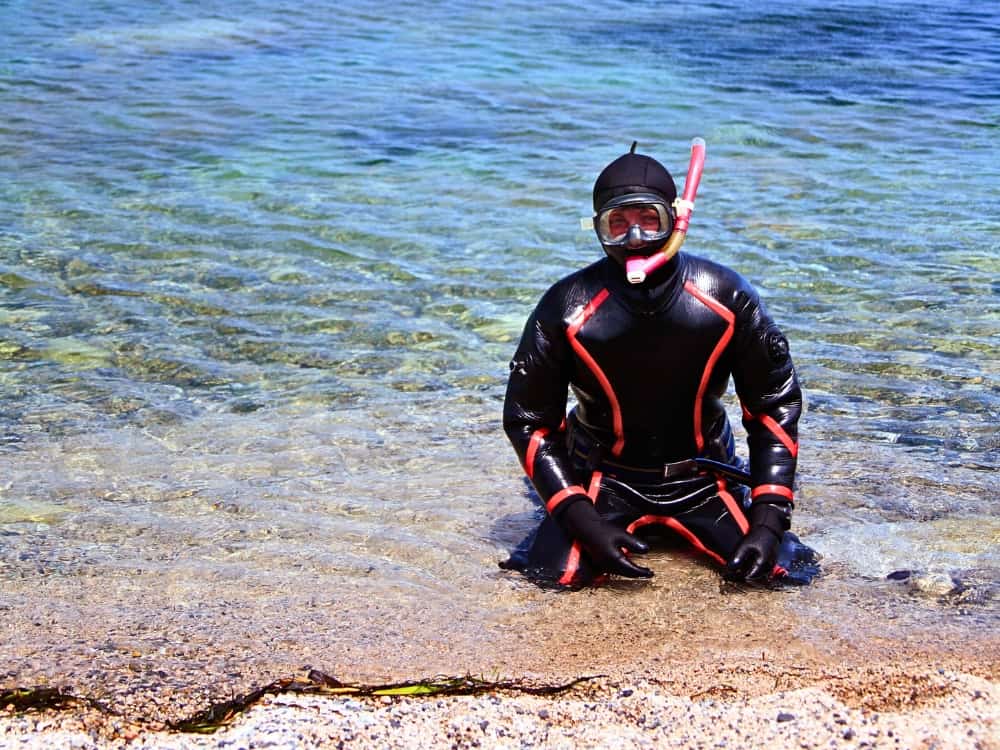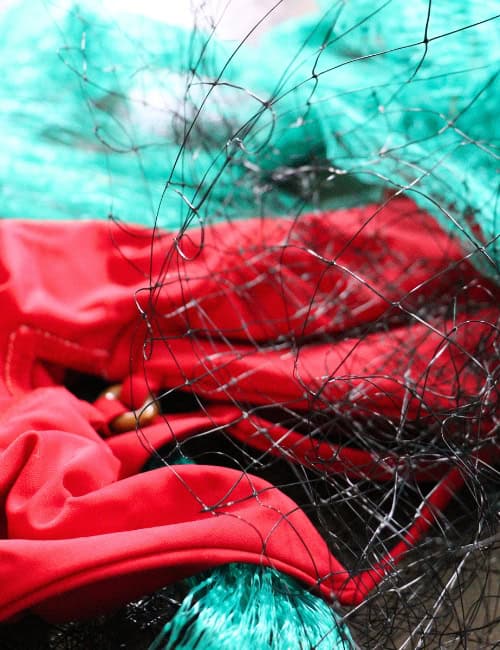
Is Neoprene Toxic? Diving Into The Synthetic Rubber Revolution
In the world of materials, neoprene—also known as polychloroprene—is a rubbery chameleon that swims seamlessly from beaches to fashion runways.
This versatile material isn’t just about hugging surfers’ curves or gracing haute couture; it’s a testament to human innovation and the intricate dance between science and style.
But beneath the waves of innovation and usefulness lurks some darker depths of this synthetic rubber as more and more people are asking the critical question: is neoprene toxic to humans?
It’s time we peel back the layers of this synthetic rubber, exploring its aquatic origins, runway ambitions, and the eco-conscious ripples it’s making in a world hungry for more sustainable substances.
So, buckle your flippers and zip up your wetsuits, as we plunge into polychloroprene and learn whether neoprene fabrics are a wet(suit) blanket on your non-toxic living goals or a neo-primo material.
The Full List Of Neoprene Safety Facts
1. What Is Neoprene Fabric Made Of?

You have no doubt heard its name, but what material is neoprene?
Neoprene is a type of synthetic rubber produced from polymerized chloroprene molecules.
Chloroprene is a monomer—a single molecule that can be combined to form a polymer chain. The polymerization process turns these chloroprene monomers into long chains, resulting in the formation of neoprene foam or rubber.
The material was first developed in the early 1930s by DuPont scientists. Initially intended for industrial purposes, its exceptional resistance to oils, chemicals, and temperature extremes led to its use in a wide range of consumer products.
Today, neoprene is especially known for its excellent insulating properties, making it a preferred choice for wetsuits, laptop sleeves, and even medical braces.
Polychloroprene vs. Neoprene
When discussing rubber materials, terms like polychloroprene and neoprene are sometimes used interchangeably, leading to confusion.
Polychloroprene is the technical term for the synthetic rubbers commonly known by its trade name “neoprene.” In other words, neoprene is a type of polychloroprene. It’s essentially what material neoprene is made of.
The term “polychloroprene” refers to the polymerized form of the monomer chloroprene, which is created through polymerization processes. This polymerization results in the formation of a versatile rubber material known for its numerous applications.
Neoprene, then, is the commercial, trademarked name coined by DuPont, the chemical company that initially developed the material.
This name became so widely recognized that it is often used colloquially to describe any polychloroprene material— much like “Ziploc” is used to refer to all kinds of plastic bags.
What Is Neoprene Fabric Good For?
Polychloroprene is renowned for its unique properties that make it a widely useful and versatile material. These properties include:
- Flexibility/ Elasticity: Neoprene fabric is highly flexible and exhibits excellent elastic behavior, making them suitable for applications requiring stretch and movement.
- Chemical Resistance: They are resistant to oils, chemicals, and solvents, making them ideal for applications in environments where exposure to such substances is common.
- Weather Resistance: Polychloroprene and neoprene display good resistance to weathering, UV radiation, and ozone, allowing them to maintain their properties even in outdoor applications.
- Insulation: Their insulating characteristics make them suitable for thermal and electrical insulation purposes, particular as wetsuit material. However, if you’re wondering, “Is neoprene waterproof?, it’s not a waterproof material, but it helps retain body heat, keeping you warm when wet.
That means that in addition to its most known application as swimsuit and wetsuit material, neoprene foam fabric is used for activewear, non-technical fashion, footwear, bags, personal flotation devices, sporting equipment, automotive interior covers, medical braces, orthopedic devices, electronic sleeves, gaskets, seals, and much more.
2. How Is Neoprene Made?

We’ve established that neoprene is a type of synthetic fabric—so is neoprene polyester? Or maybe nylon?
Nope, but like most synthetic fabrics, they share characteristics of being petroleum-based and processed via a long list of chemically-intensive steps.
Neoprene fabric, a synthetic rubber material with a wide range of applications, is created through a polymerization process that involves combining chloroprene molecules. This process results in a polymer chain, forming the basis of neoprene fabrics.
The manufacturing of neoprene involves several key steps:
- Chloroprene Synthesis: Acetylene or butadiene are synthesized via chemical reactions to create chloroprene monomers.
- Polymerization: Chloroprene monomers undergo emulsion polymerization, suspending the monomers in water and initiating a reaction with the help of emulsifiers and activators.
- Stabilization & Vulcanization: The resulting neoprene rubber is stabilized using chemicals to prevent degradation during storage and transportation. Vulcanization, a process involving the addition of sulfur and heat, enhances elasticity and strength.
- Coagulation: The neoprene latex is coagulated, which involves separating the rubber solids from the liquid, either through chemical coagulation or centrifugation.
- Milling & Calendering: The solid neoprene rubber is then milled to achieve the desired consistency and texture. Calendering, a process that involves passing the material through rollers to flatten into a neoprene sheet, further refines its thickness and surface texture.
- Textile Lamination: Neoprene swimsuits and wetsuits often feature a textile layer on one or both sides, bonded to the neoprene fabric using adhesives or other bonding techniques.
- Curing & Finishing: The neoprene fabrics are cured, which involves applying heat and pressure to enhance its final properties. Various finishing treatments can be applied to improve the fabric’s appearance, durability, and performance.
Understanding how neoprene is made and what it’s composed of is crucial if we are to understand the potential environmental impact of neoprene.
3. Is Neoprene Toxic?

That’s a lot of chemical-soaked steps, which begs the important question: is it safe to wear neoprene? Is neoprene safe for skin contact? And if not, why is neoprene bad?
Neoprene itself is not inherently toxic, and it has been deemed “safe” for use in various consumer products—but then again, so have things like formaldehyde and synthetic fragrances.
As with anything that purports to be safe, neoprene deserves to be treated skeptically to avoid greenwashing.
Neoprene toxicity is still very much up in the air (or rather, submerged beneath the waves), which is concerning in its own right. The fact is, we just don’t know exactly how it affects human or environmental health.
Does Neoprene Contain Latex?
While neoprene does not contain latex, it may cause a similar allergic reaction for people with a sensitivity to latex due to similar chemical structure.
Since contact dermatitis (a type of skin irritation accompanied by redness, itching, swelling, and sometimes blisters) is often reported as a post-neoprene allergic reaction, the Environmental Working Group (EWG) named neoprene the 2009 allergen of the year.
Whether neoprene is safe on skin somewhat depends on how sensitive your skin is.
Does Neoprene Contain Lead?
Lead is not a component of its neoprene’s chemical structure.
However, the production process and potential additives used during the manufacturing of neoprene products could introduce the possibility of trace amounts of contaminants, including lead and carbon black, a harmful chemical used to give neoprene its black color.
If you are concerned about the presence of lead in neoprene fabric, it’s a good idea to look for products that comply with relevant safety standards and regulations (like OEKO-TEX certification).
Is Neoprene Carcinogenic?
Now for the big question: does neoprene cause cancer?
It’s a valid question, considering chloroprene (the base of neoprene) is classified as a Volatile Organic Compound (VOC)—a chemical class commonly associated with cancer.
As of now, the EPA has not dubbed neoprene or chloroprene as carcinogenic, but concerns about the potential for carcinogenic compounds, dyes, or coatings to be present in neoprene fabric may arise due to the manufacturing process or additives used.
California Proposition 65, however, has dubbed chloroprene a carcinogen, though it admits that wearing neoprene material is unlikely to be enough to cause enough exposure to chloroprene to be of any danger.
The greatest danger of neoprene is that which it poses for regularly exposed to chloroprene, like factory workers and those near manufacturing locations.
Acute exposure to high concentrations of neoprene may lead to dizziness, fatigue, headache and respiratory irritation (at best) and damage the lungs, kidney, liver, and nervous systems (at worst).
The Centers for Disease Control and Prevention (CDC) correlates skin and lung cancer with the chloroprene, particularly for those who work directly with the substance.
In fact, those near DuPont manufacturing sites in Louisville, Kentucky and Reserve, Louisiana have complained about chemical odors and, says one resident, “almost every household has someone that has died from cancer”.
While DuPont no longer manufactures in Kentucky, the Louisiana factory continues, leading to a locational cancer risk 50 times the national average.
All in all, while neoprene may be safe to wear, it’s certainly not safe to manufacture—which leads us to ask what other negative impacts it’s having on the world.
4. Is Neoprene Eco-Friendly?

Neoprene is a versatile material with desirable properties, helping its popularity across industries, from sports gear to fashion accessories.
However, its production raises a slew of human safety and environmental safety concerns.
Raw Materials & Production:
Neoprene is primarily derived from petroleum, a non-renewable fossil fuel. This reliance on oil as a feedstock raises concerns about resource depletion and contributes to carbon emissions.
The energy and chemical-intensive nature of neoprene production furthers its environmental impact. The process involves the use of various chemicals, such as accelerators and activators, which can pose risks to both human health and ecosystems if not properly managed.
Advancements in manufacturing techniques have helped minimize the environmental impact of the process, but it’s unfortunately difficult to determine what brands producing polychloroprene are using these more responsible techniques.
Carbon Footprint:
The carbon footprint of neoprene production is a significant concern due to its reliance on fossil fuels. The extraction, processing, and transportation of petroleum contribute to greenhouse gas emissions and climate change.
As the world strives to reduce carbon emissions to combat global warming, industries are increasingly seeking more sustainable alternatives to traditional materials.
Chemical Leaching:
While there isn’t evidence to back this up at this time, neoprene may leak chemicals into the water, particularly when the material is exposed to heat or sunlight—you know…like when you’re surfing!
This means the answer to the question, “Is neoprene foam toxic to animals?”, may well be a ‘no’.
Waste Generation:
The production of neoprene generates waste in the form of byproducts and chemicals used in the manufacturing process. These waste products can contribute to pollution and environmental degradation.
Additionally, neoprene is challenging to recycle through traditional recycling methods due to its composition and structure. That means it typically needs to be chemically recycled (great, more chemicals…) and even then, finding services to do so is challenging.
That means a large portion of neoprene products end up as landfill waste after their useful life—to the tune of 419 tons in the UK alone every year.
Is Neoprene Vegan?
Neoprene is not derived from animal sources, making it suitable for those adhering to a vegan lifestyle.
However, its environmental impact raises questions about its overall ethical compatibility.
Plus, there’s no guarantee that the adhesives commonly used in neoprene products (say, to seal the seams in that neoprene wetsuit) aren’t animal-derived.
For all these reasons, many sustainable living advocates may choose to seek out sustainable neoprene alternatives.
5. Neoprene Alternatives

As environmental awareness grows, so does the demand for sustainable and eco-friendly wetsuits.
Several neoprene alternatives have emerged that aim to provide similar performance while minimizing environmental harm. Some of these alternatives include:
- Yulex®: Made from renewable natural rubber, Yulex® offers a more sustainable neoprene alternative. Its production involves fewer chemicals and relies on a plant-based source.
- Limestone Neoprene: This neoprene alternative uses calcium carbonate from limestone as a replacement for some of the petroleum-based materials in traditional neoprene production. It offers improved elasticity and reduced reliance on fossil fuels.
- Recycled Neoprene: Some manufacturers are experimenting with using recycled neoprene, reducing the demand for virgin materials and diverting waste from landfills. This doesn’t mitigate neoprene toxicity risks, but it does ensure no new chloroprene manufacturing is taking place.
Sustainable neoprene alternatives haven’t yet been adopted on an industrial scale, but the sustainable fashion industry has taken note—especially when it comes to sustainable wetsuits.
Sustainable outdoor clothing monolith Patagonia now offers neoprene-free wetsuits made from Yulex®.
While not non-neoprene wetsuits, a number of other big name surf brands (like Roxy and Billabong) have incorporated recycled neoprene into their product lines.
Did you know we Have a Newsletter?
We cover the latest in sustainable living, fashion, zero waste, beauty, travel, finance and more…
Final Thoughts On Whether Neoprene Is Safe To Wear?
Let’s cut to the chase (of some waves): is neoprene clothing toxic?
Based on what we know now, probably not—for you, anyway.
While your neoprene swimsuit itself is likely not toxic as you wear it, concerns linger about the chemicals involved in its production and the effect they have on both those exposed at the production level and the environment.
Ultimately, conventional neoprene relies on petroleum-derived feedstocks, energy-intensive processes, and chemicals that pose potential risks to both human health and the environment.
Still, because making it was so costly, keep wearing your neoprene wetsuit and be sure to properly dispose of it when it wears out. But when it comes time to replace it, opt for natural rubber or some other sustainable swimsuit.
And if you really want to make waves in the world of slow fashion, tell your surfing bud that sustainable neoprene alternatives are pretty swell by sharing this article.
Pin these:





